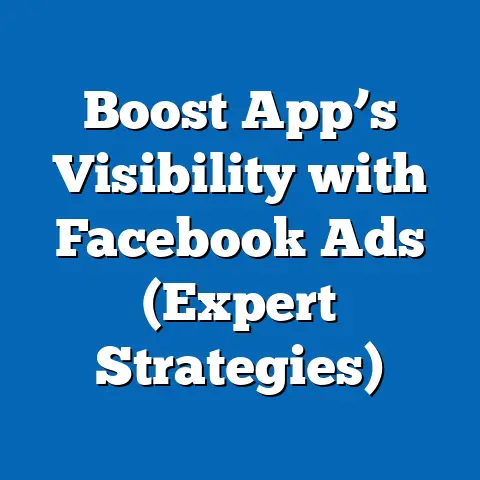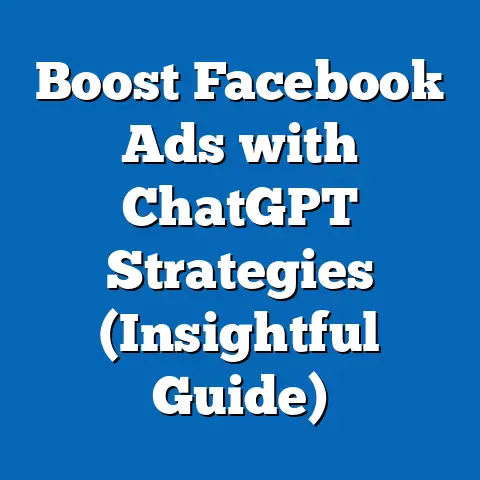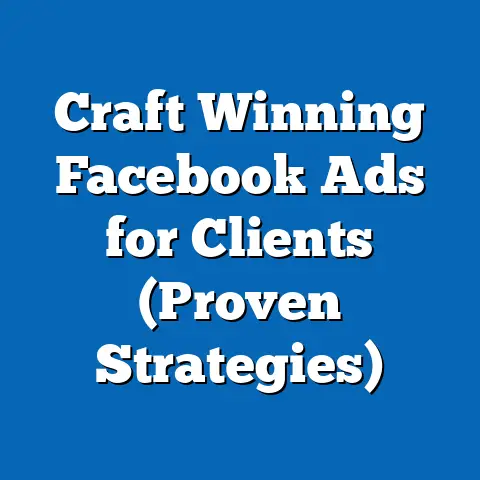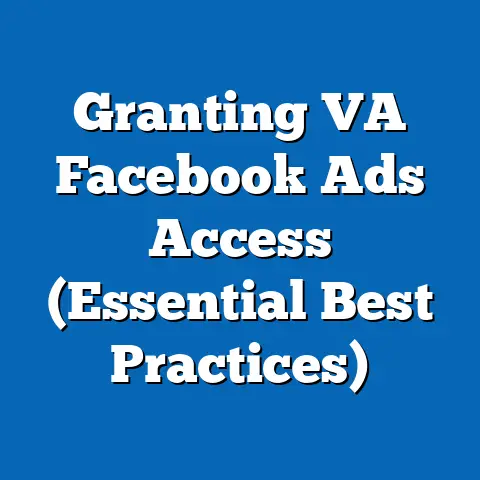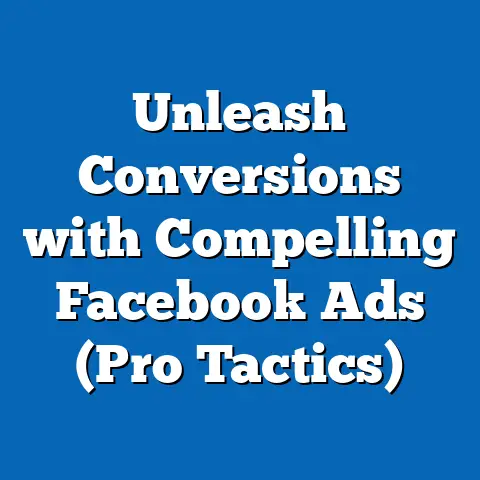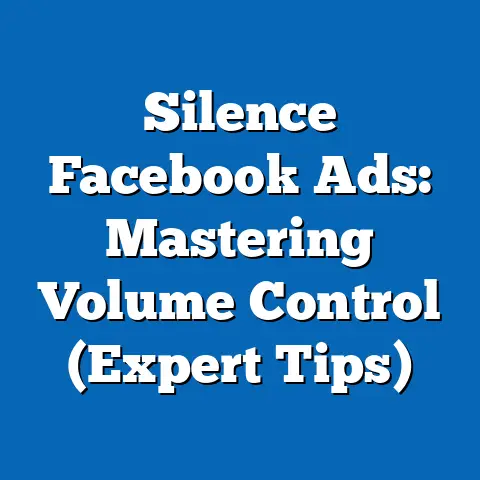Maximize Med Spa Facebook Ads Success (Proven Strategies)
The world of med spas is booming. People are increasingly seeking non-invasive cosmetic procedures and wellness treatments, leading to a surge in the popularity of these establishments. But with this growth comes increased competition. In today’s digital age, a strong online presence is no longer optional; it’s essential for survival. And when it comes to reaching your target audience, Facebook advertising offers unparalleled opportunities.
From defining your ideal client to crafting irresistible ad copy and analyzing your campaign performance, I’ll walk you through every step of the process. Get ready to unlock the full potential of Facebook advertising and watch your med spa flourish.
Understanding Your Target Audience
Before you even think about creating an ad, you need to know who you’re talking to. Who is your ideal med spa client? What are their demographics, interests, and pain points? This is where understanding your target audience becomes paramount.
Defining the Typical Med Spa Client
While every med spa is different and caters to slightly different niches, there are some common characteristics you’ll find in the typical client profile. Consider these factors:
- Demographics:
- Age: The sweet spot often lies between 25 and 55, though this can vary depending on the specific treatments offered. Anti-aging treatments might attract an older demographic, while acne treatments are popular among younger clients.
- Gender: While both men and women visit med spas, the majority of clients are typically women. However, the male market is growing, so it’s important not to ignore this segment.
- Location: Obviously, you’ll be targeting people within a reasonable driving distance of your med spa.
- Income: Med spa treatments can be a significant investment, so your target audience typically has a disposable income that allows them to prioritize self-care and aesthetic enhancements.
- Interests:
- Beauty and Wellness: This is a no-brainer. Your target audience is interested in maintaining their appearance, feeling good about themselves, and exploring different beauty and wellness trends.
- Health and Fitness: Many med spa clients are also health-conscious and interested in fitness, nutrition, and overall well-being.
- Luxury and Lifestyle: They may enjoy high-end products, travel, and experiences that enhance their lifestyle.
- Specific Treatments: Consider the specific treatments you offer. Someone interested in Botox will likely have different interests than someone interested in laser hair removal.
- Pain Points:
- Aging Concerns: Wrinkles, fine lines, age spots, and sagging skin are common concerns.
- Skin Imperfections: Acne, scars, uneven skin tone, and hyperpigmentation can impact self-esteem.
- Unwanted Hair: Many people seek laser hair removal for convenience and to eliminate the hassle of shaving or waxing.
- Body Image Issues: Concerns about weight, cellulite, or specific body areas can drive people to seek body contouring or skin tightening treatments.
- Lack of Time: Busy professionals may seek quick and effective treatments that fit into their hectic schedules.
- Age: The sweet spot often lies between 25 and 55, though this can vary depending on the specific treatments offered. Anti-aging treatments might attract an older demographic, while acne treatments are popular among younger clients.
- Gender: While both men and women visit med spas, the majority of clients are typically women. However, the male market is growing, so it’s important not to ignore this segment.
- Location: Obviously, you’ll be targeting people within a reasonable driving distance of your med spa.
- Income: Med spa treatments can be a significant investment, so your target audience typically has a disposable income that allows them to prioritize self-care and aesthetic enhancements.
- Beauty and Wellness: This is a no-brainer. Your target audience is interested in maintaining their appearance, feeling good about themselves, and exploring different beauty and wellness trends.
- Health and Fitness: Many med spa clients are also health-conscious and interested in fitness, nutrition, and overall well-being.
- Luxury and Lifestyle: They may enjoy high-end products, travel, and experiences that enhance their lifestyle.
- Specific Treatments: Consider the specific treatments you offer. Someone interested in Botox will likely have different interests than someone interested in laser hair removal.
- Aging Concerns: Wrinkles, fine lines, age spots, and sagging skin are common concerns.
- Skin Imperfections: Acne, scars, uneven skin tone, and hyperpigmentation can impact self-esteem.
- Unwanted Hair: Many people seek laser hair removal for convenience and to eliminate the hassle of shaving or waxing.
- Body Image Issues: Concerns about weight, cellulite, or specific body areas can drive people to seek body contouring or skin tightening treatments.
- Lack of Time: Busy professionals may seek quick and effective treatments that fit into their hectic schedules.
Creating Audience Personas
Once you have a general understanding of your target audience, it’s time to create detailed audience personas. A persona is a fictional representation of your ideal client, based on research and data about your existing customers.
For example, you might create a persona named “Sarah,” a 35-year-old marketing manager who is concerned about the appearance of fine lines and wrinkles. She’s interested in Botox and other anti-aging treatments but is nervous about looking “fake.” She values natural-looking results and a professional, trustworthy provider.
By creating these personas, you can better tailor your ads to address specific needs and desires. You can use language and visuals that resonate with each persona, making your ads more relevant and effective.
Leveraging Facebook’s Audience Targeting Tools
Facebook offers a wealth of targeting options that allow you to reach your ideal audience with laser precision. Here are some of the most powerful tools for med spas:
- Demographic Targeting: Target people based on age, gender, location, income, education, and other demographic factors.
- Interest Targeting: Target people based on their interests, hobbies, and activities. You can target people interested in beauty, wellness, skincare, specific treatments (like Botox or laser hair removal), and related topics.
- Behavior Targeting: Target people based on their online behavior, such as purchase history, website visits, and engagement with specific types of content.
- Custom Audiences: This is where things get really interesting. Custom Audiences allow you to upload your existing customer list (email addresses or phone numbers) and target those people directly on Facebook. You can also create Custom Audiences based on website visitors or people who have interacted with your Facebook page.
- Lookalike Audiences: This is one of my favorite tools. Lookalike Audiences allow you to create a new audience that is similar to your existing customers. Facebook analyzes your Custom Audience and identifies the common characteristics of those people, then finds other people on Facebook who share those characteristics. This is a fantastic way to expand your reach and find new potential clients.
Case Studies and Examples
Let’s look at some real-world examples of successful audience targeting by med spas:
- Example 1: A med spa specializing in acne treatments created a Custom Audience based on website visitors who had viewed their acne treatment pages. They then created a Lookalike Audience based on that Custom Audience, targeting young adults in their local area who were interested in skincare and beauty. This campaign resulted in a significant increase in inquiries and bookings for acne treatments.
- Example 2: A med spa offering anti-aging treatments created a Custom Audience based on their existing clients who were over the age of 45. They then targeted this audience with ads showcasing their Botox and filler services, emphasizing natural-looking results and the expertise of their providers. This campaign resulted in a high conversion rate and increased revenue from existing clients.
- Example 3: A med spa launching a new body contouring treatment created a Lookalike Audience based on their existing clients who had previously purchased weight loss or fitness-related services. They targeted this audience with ads showcasing the benefits of the new treatment, emphasizing its ability to help them achieve their body goals. This campaign generated a lot of buzz and quickly filled up their appointment slots.
Key Takeaways:
- Understanding your target audience is the foundation of successful Facebook advertising.
- Create detailed audience personas to better tailor your ads to specific needs and desires.
- Leverage Facebook’s powerful targeting tools, including Custom Audiences and Lookalike Audiences, to reach the right people.
- Analyze your campaign data to identify your most effective audiences and refine your targeting strategy.
Next Steps:
- Define your ideal client profile: Consider demographics, interests, and pain points.
- Create audience personas: Develop detailed representations of your ideal clients.
- Explore Facebook’s targeting options: Familiarize yourself with the various tools available.
- Experiment with Custom Audiences and Lookalike Audiences: Start building these valuable audiences.
Crafting Compelling Ad Content
Once you’ve identified your target audience, it’s time to create ad content that grabs their attention and compels them to take action. This is where your creativity and understanding of your clients’ needs come into play.
Essential Elements of Facebook Ad Content
The most effective Facebook ads for med spas typically include these key elements:
- High-Quality Visuals:
- Images: Use professional, high-resolution images that showcase your treatments and results. Before-and-after photos are incredibly powerful, but make sure you have the client’s permission and that the photos are authentic and unedited. Lifestyle images that depict the desired outcome (e.g., someone feeling confident and beautiful) can also be effective.
- Videos: Videos are even more engaging than images. Create videos that showcase your med spa, introduce your team, explain your treatments, or share client testimonials. Short, informative videos that address common questions or concerns can be particularly effective.
- Engaging Ad Copy:
- Headline: Your headline is the first thing people will see, so make it count. Use strong, attention-grabbing language that speaks to your target audience’s needs and desires.
- Body Text: Your body text should provide more details about your offer and explain the benefits of your treatments. Focus on how your med spa can help clients achieve their goals and improve their self-esteem.
- Call to Action: Tell people what you want them to do. Use clear and concise calls to action, such as “Book Your Consultation,” “Learn More,” or “Shop Now.”
- Professional Tone:
- Maintain a professional and trustworthy tone in all of your ad content. Avoid hype or exaggerated claims. Focus on providing accurate information and building trust with your audience.
- Images: Use professional, high-resolution images that showcase your treatments and results. Before-and-after photos are incredibly powerful, but make sure you have the client’s permission and that the photos are authentic and unedited. Lifestyle images that depict the desired outcome (e.g., someone feeling confident and beautiful) can also be effective.
- Videos: Videos are even more engaging than images. Create videos that showcase your med spa, introduce your team, explain your treatments, or share client testimonials. Short, informative videos that address common questions or concerns can be particularly effective.
- Headline: Your headline is the first thing people will see, so make it count. Use strong, attention-grabbing language that speaks to your target audience’s needs and desires.
- Body Text: Your body text should provide more details about your offer and explain the benefits of your treatments. Focus on how your med spa can help clients achieve their goals and improve their self-esteem.
- Call to Action: Tell people what you want them to do. Use clear and concise calls to action, such as “Book Your Consultation,” “Learn More,” or “Shop Now.”
- Maintain a professional and trustworthy tone in all of your ad content. Avoid hype or exaggerated claims. Focus on providing accurate information and building trust with your audience.
Tips for Writing Engaging Ad Copy
- Speak to your audience’s needs: Address their specific pain points and desires.
- Highlight the benefits, not just the features: Explain how your treatments can improve their lives.
- Use strong verbs and action-oriented language: Encourage people to take action.
- Keep it concise and easy to read: People are scrolling quickly, so get to the point.
- Use a consistent brand voice: Maintain a consistent tone and style across all of your ads.
- Include social proof: Testimonials, reviews, and before-and-after photos can build trust.
Examples of Successful Ad Creatives
Let’s analyze some examples of successful ad creatives from med spas:
- Example 1: A med spa running an ad for Botox features a high-quality before-and-after photo showcasing natural-looking results. The headline reads, “Erase Fine Lines and Wrinkles with Botox.” The body text explains the benefits of Botox and emphasizes the expertise of their providers. The call to action is “Book Your Consultation.”
- Example 2: A med spa running an ad for laser hair removal uses a short video showing the process of laser hair removal and highlighting its convenience and effectiveness. The headline reads, “Say Goodbye to Shaving and Waxing!” The body text explains the benefits of laser hair removal and offers a special discount for new clients. The call to action is “Learn More.”
- Example 3: A med spa running an ad for a new body contouring treatment features a lifestyle image of a confident woman wearing a fitted dress. The headline reads, “Sculpt Your Dream Body with [Treatment Name].” The body text explains how the treatment works and emphasizes its ability to help clients achieve their body goals. The call to action is “Book Your Free Consultation.”
The Importance of Seasonal and Promotional Content
Don’t forget to create seasonal and promotional content to capitalize on holidays, special events, and seasonal trends.
- Holidays: Run ads promoting gift certificates for Mother’s Day, Valentine’s Day, or Christmas.
- Seasonal Trends: Promote skincare treatments in the spring to prepare for summer or offer laser hair removal packages before swimsuit season.
- Special Events: Offer discounts or promotions for birthdays, anniversaries, or other special occasions.
Creating Urgency in Ad Campaigns
Creating a sense of urgency can encourage people to take action quickly. Here are some tactics you can use:
- Limited-time offers: “Offer ends soon!”
- Limited availability: “Only a few spots left!”
- Exclusive discounts: “For new clients only!”
- Countdown timers: Use countdown timers in your ads to create a sense of urgency.
Key Takeaways:
- Compelling ad content is essential for attracting attention and driving results.
- Use high-quality visuals, engaging ad copy, and clear calls to action.
- Maintain a professional and trustworthy tone.
- Create seasonal and promotional content to capitalize on trends and events.
- Create urgency to encourage people to take action quickly.
Next Steps:
- Gather high-quality visuals: Invest in professional photos and videos.
- Craft compelling ad copy: Focus on benefits, not just features.
- Create a variety of ads: Test different headlines, body text, and calls to action.
- Develop a content calendar: Plan out your seasonal and promotional content.
Leveraging Facebook’s Ad Formats
Facebook offers a variety of ad formats, each with its own unique advantages. Understanding these formats and how to use them effectively is crucial for maximizing the impact of your campaigns.
Exploring the Various Ad Formats
Here’s a rundown of some of the most popular ad formats for med spas:
- Image Ads: These are the simplest and most common type of ad. They consist of a single image, a headline, and body text. Image ads are great for showcasing your treatments and brand.
- Video Ads: Video ads are more engaging than image ads and can be used to tell a story, demonstrate a treatment, or share client testimonials.
- Carousel Ads: Carousel ads allow you to showcase multiple images or videos in a single ad. This format is great for highlighting a variety of treatments or showcasing different aspects of a single treatment.
- Slideshow Ads: Slideshow ads are similar to video ads but are created using a series of images. They are a cost-effective way to create engaging video-like content.
- Collection Ads: Collection ads are designed for e-commerce businesses and allow you to showcase a collection of products in a visually appealing format. While not directly applicable for service-based businesses, if you sell skincare products, this could be a good option.
- Lead Ads: Lead ads allow you to collect leads directly from Facebook without sending people to your website. This format is great for generating inquiries and building your email list.
- Instant Experience Ads (formerly Canvas Ads): These are full-screen, mobile-optimized ads that provide an immersive experience for users. They can include images, videos, text, and interactive elements.
When and How to Use Each Format Effectively
- Image Ads: Use image ads for simple, straightforward promotions or to showcase your brand.
- Video Ads: Use video ads to tell a story, demonstrate a treatment, or share client testimonials.
- Carousel Ads: Use carousel ads to showcase multiple treatments or highlight different aspects of a single treatment.
- Slideshow Ads: Use slideshow ads as a cost-effective alternative to video ads.
- Lead Ads: Use lead ads to generate inquiries and build your email list. Offer a free consultation or a discount in exchange for contact information.
- Instant Experience Ads: Use Instant Experience Ads to create an immersive experience for users and showcase your med spa in a visually appealing way.
The Importance of A/B Testing
A/B testing is the process of comparing two versions of an ad to see which one performs better. You can A/B test different ad formats, headlines, body text, images, and calls to action.
- Example: You could A/B test an image ad against a video ad to see which format generates more leads.
- Example: You could A/B test two different headlines to see which one attracts more clicks.
By A/B testing your ads, you can identify what works best for your specific audience and optimize your campaigns for maximum results.
Incorporating Customer Testimonials and Before-and-After Images
Customer testimonials and before-and-after images are powerful tools for building trust and credibility.
- Customer Testimonials: Include quotes from satisfied clients in your ad copy or create video testimonials.
- Before-and-After Images: Showcase the results of your treatments with authentic and unedited before-and-after photos. Make sure you have the client’s permission to use their photos.
Key Takeaways:
- Facebook offers a variety of ad formats, each with its own unique advantages.
- Choose the ad format that best suits your message and target audience.
- A/B test different ad formats and elements to optimize your campaigns.
- Incorporate customer testimonials and before-and-after images to build trust.
Next Steps:
- Explore Facebook’s ad formats: Familiarize yourself with the different options available.
- Experiment with different formats: Test which formats work best for your med spa.
- A/B test your ads: Continuously optimize your campaigns based on performance data.
- Gather customer testimonials and before-and-after images: Use these to build trust and credibility.
Budgeting and Bidding Strategies
Understanding how to budget your Facebook ad spend and choose the right bidding strategy is essential for maximizing your return on investment (ROI). It’s not just about spending money; it’s about spending it wisely.
Budgeting Options
Facebook offers two main budgeting options:
- Daily Budget: This is the average amount you’re willing to spend per day on your ad campaign. Facebook will try to spend your daily budget each day, but it may spend slightly more or less depending on performance.
- Lifetime Budget: This is the total amount you’re willing to spend on your ad campaign over its entire duration. Facebook will try to distribute your budget evenly over the campaign’s lifetime.
Choosing the Right Budget
The right budget for your med spa will depend on several factors, including:
- Your Goals: What are you trying to achieve with your ad campaign? Are you trying to generate leads, drive traffic to your website, or increase sales?
- Your Target Audience: How large is your target audience? The larger your audience, the more you’ll need to spend to reach them.
- Your Competition: How much are your competitors spending on Facebook ads?
- Your Budget: How much money do you have available to spend on advertising?
Tips for Making the Most of Your Advertising Spend
- Start Small: Begin with a small budget and gradually increase it as you see results.
- Target Precisely: Use Facebook’s targeting options to reach the right people and avoid wasting money on irrelevant audiences.
- Optimize Your Ads: Continuously A/B test your ads and optimize them for maximum performance.
- Monitor Your Results: Track your campaign performance closely and adjust your budget and targeting as needed.
Bidding Strategies
Facebook offers several bidding strategies that determine how much you pay for each ad interaction. Here are some of the most common options:
- Cost Per Click (CPC): You pay each time someone clicks on your ad. This is a good option if you’re trying to drive traffic to your website.
- Cost Per Impression (CPM): You pay for every 1,000 impressions your ad receives. This is a good option if you’re trying to increase brand awareness.
- Cost Per Action (CPA): You pay when someone takes a specific action, such as signing up for your email list or booking a consultation. This is a good option if you’re trying to generate leads or drive conversions.
- Lowest Cost: Facebook automatically bids to get you the most results for your budget. This is a good option if you’re new to Facebook advertising and want to let Facebook optimize your bids.
- Target Cost: You set a target cost per result, and Facebook tries to get you results at or below that cost. This is a good option if you have a specific cost per acquisition (CPA) goal in mind.
Optimizing Bidding Strategies for Specific Campaign Goals
- Lead Generation: Use CPA bidding and optimize for leads.
- Website Traffic: Use CPC bidding and optimize for clicks.
- Brand Awareness: Use CPM bidding and optimize for impressions.
Scaling Successful Ad Campaigns
Once you’ve identified a successful ad campaign, you’ll want to scale it up to reach a larger audience and generate even more results. Here are some tips for scaling your campaigns effectively:
- Increase Your Budget: Gradually increase your budget to reach a larger audience.
- Expand Your Targeting: Expand your targeting to include similar audiences.
- Duplicate Your Campaigns: Duplicate your successful campaigns and target different audiences.
- A/B Test Continuously: Continue A/B testing your ads and optimizing them for maximum performance.
Key Takeaways:
- Understanding budgeting and bidding strategies is essential for maximizing your ROI.
- Choose the right budget and bidding strategy based on your goals and target audience.
- Monitor your results closely and adjust your budget and targeting as needed.
- Scale successful ad campaigns effectively to reach a larger audience and generate even more results.
Next Steps:
- Determine your advertising goals: What are you trying to achieve with your campaigns?
- Set a budget: How much money do you have available to spend on advertising?
- Choose a bidding strategy: Select the strategy that best aligns with your goals.
- Monitor your results: Track your campaign performance closely and adjust your strategy as needed.
Measuring Success and Analyzing Data
Running Facebook ads without tracking your results is like driving a car blindfolded. You need to know where you’re going and how you’re getting there. Measuring success and analyzing data is crucial for understanding what’s working, what’s not, and how to optimize your campaigns for maximum ROI.
Key Performance Indicators (KPIs) for Med Spas
Here are some of the most important KPIs that med spas should track:
- Reach: The number of unique people who saw your ad.
- Impressions: The number of times your ad was displayed.
- Clicks: The number of times people clicked on your ad.
- Click-Through Rate (CTR): The percentage of people who saw your ad and clicked on it. (Clicks / Impressions) x 100
- Cost Per Click (CPC): The average cost you paid for each click on your ad.
- Leads: The number of people who submitted a lead form or contacted your med spa after seeing your ad.
- Cost Per Lead (CPL): The average cost you paid for each lead.
- Conversions: The number of people who booked a consultation or purchased a treatment after seeing your ad.
- Conversion Rate: The percentage of people who clicked on your ad and converted. (Conversions / Clicks) x 100
- Return on Ad Spend (ROAS): The amount of revenue you generated for every dollar you spent on advertising. (Revenue / Ad Spend)
- Website Traffic: The number of people who visited your website after seeing your ad.
- Engagement: The number of likes, comments, and shares your ad received.
Using Facebook Ads Manager to Analyze Data
Facebook Ads Manager is your central hub for tracking and analyzing your ad performance. Here’s how to use it effectively:
- Customize Your Columns: Choose the metrics that are most important to you and add them to your Ads Manager columns.
- Filter Your Data: Filter your data by date range, campaign, ad set, or ad to get a more granular view of your performance.
- Use the Reporting Tab: The Reporting tab allows you to create custom reports and analyze your data in more detail.
- Track Conversions: Set up conversion tracking to track the number of people who book a consultation or purchase a treatment after seeing your ad.
- Use Pixel Data: The Facebook Pixel tracks website activity and allows you to create retargeting audiences and optimize your ads for conversions.
Interpreting Data and Making Data-Driven Decisions
- Low CTR: If your CTR is low, it means your ad is not engaging enough. Try testing different headlines, images, or body text.
- High CPC: If your CPC is high, it means you’re paying too much for each click. Try refining your targeting or optimizing your bids.
- Low Conversion Rate: If your conversion rate is low, it means people are clicking on your ad but not taking the desired action. Try improving your landing page or offering a more compelling offer.
- Low ROAS: If your ROAS is low, it means you’re not generating enough revenue for your ad spend. Try optimizing your campaigns or targeting a different audience.
Continuous Improvement Based on Analytics and Industry Trends
The world of Facebook advertising is constantly evolving. It’s important to stay up-to-date on the latest trends and best practices and continuously improve your campaigns based on analytics.
- Follow Industry Blogs and Experts: Stay informed about the latest trends and best practices in Facebook advertising.
- Attend Webinars and Conferences: Learn from industry experts and network with other advertisers.
- Experiment Continuously: Don’t be afraid to try new things and experiment with different strategies.
- Analyze Your Data Regularly: Track your campaign performance closely and adjust your strategy as needed.
Key Takeaways:
- Measuring success and analyzing data is crucial for optimizing your Facebook ad campaigns.
- Track the key performance indicators (KPIs) that are most important to your med spa.
- Use Facebook Ads Manager to analyze your data and identify areas for improvement.
- Make data-driven decisions based on your results.
- Stay up-to-date on the latest trends and best practices and continuously improve your campaigns.
Next Steps:
- Set up conversion tracking: Track the number of people who book a consultation or purchase a treatment after seeing your ad.
- Customize your Ads Manager columns: Choose the metrics that are most important to you.
- Analyze your data regularly: Track your campaign performance closely and identify areas for improvement.
- Stay informed: Follow industry blogs and experts and attend webinars and conferences.
Conclusion
Facebook advertising offers an incredible opportunity for med spas to reach their target audience, generate leads, and drive business growth. However, success requires a strategic approach that is tailored to the unique needs and challenges of the med spa industry.
In this article, I’ve shared proven strategies for maximizing your Facebook ad success, from understanding your target audience to crafting compelling ad content, leveraging Facebook’s ad formats, budgeting and bidding strategies, and measuring success and analyzing data.
By embracing these strategies and continuously optimizing your campaigns, you can unlock the full potential of Facebook advertising and transform the visibility and success of your med spa. Don’t be afraid to experiment, test new things, and learn from your results. The world of Facebook advertising is constantly evolving, so it’s important to stay informed and adapt your strategy as needed.
Remember, a well-crafted Facebook ad campaign can be a game-changer for your med spa. It’s an investment in your business that can pay off handsomely in the form of increased leads, bookings, and revenue. So, take the time to learn the ropes, implement these strategies, and watch your med spa flourish.
Call to Action:
Now it’s your turn! Share your own experiences with Facebook ads in the med spa industry in the comments below. What strategies have worked for you? What challenges have you faced? Let’s learn from each other and help each other succeed. And don’t forget to share this article with your fellow med spa owners who could benefit from these proven strategies. Together, we can elevate the med spa industry and help more people feel confident and beautiful.

